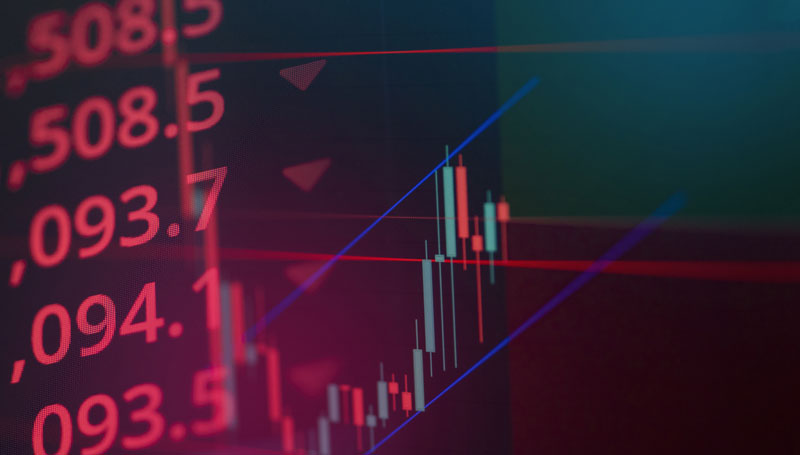

17.08.2020 – Special Report. Deflation or inflation? Recession and crash on the stock market or new inflation due to the flood of money from central banks? No one can currently answer this question of all questions. Two assets protect against both threats: Gold and big tech stocks. And the latter also offer a call option for an economic recovery.
Price Overshoot
The central banks are responsible for a “price overshoot” in big tech and gold, Mohamed Aly El-Erian, former CEO of the Pacific Investment Management Company, recently wrote in the “Financial Times”. PIMCO is one of the largest fund managers in the world. For one thing, the rally in gold was an unintended outcome in an ever-lengthening list of extraordinary central bank interventions in the market.
Gold is bipolar
Viele Anleger hätten Gold zuvor als kurzfristigen Momentum-Trade gesehen; nun aber nehme es eher den Status als Standalone-Investment ein. Denn Gold habe eine bipolare Funktion: Als Hedge gegen einen Deflation, sprich eine Depression und einen großen Crash an einem Aktienmarkt, der komplett von der Realwelt entkoppelt ist. Und auch als Absicherung gegen eine Inflation, die durch die Entwertung des Papiergeldes entsteht.
Big Tech gegen Inflation und Deflation
Und es gibt laut El-Erian noch eine zweite Assetklasse, die diese Bipolarität aufweist: Die Big-Tech-Aktien. Die großen Titel an der Wall Street versprächen Wachstum sowie eine Verschiebung des physischen Handels in die virtuelle Welt während der Pandemie; außerdem eine Absicherung nach unten wegen der massiven Cash-Positionen, niedrigen Schulden und der positiven Cash-Flow-Generierung.
Ausnahmestellung der Tech-Konzerne
Tatsächlich hatte die Berichtssaison im zweiten Quartal die Vormachtstellung von Big Tech eindrucksvoll belegt: Der Gewinn je Aktie der FAAMG – Facebook, Amazon, Apple, Microsoft und Google – stieg um 2 Prozent. Die anderen 495 Aktien im S&P 500 mussten ein Minus von 38 Prozent hinnehmen, wie das Blog ZeroHedge auswertete. Und die Earnings per Share bei kleinen Unternehmen sahen noch schlimmer aus: Im Russell 2000 rutschte das EPS um 97 Prozent ab. Goldman Sachs kommentierte: “The FAAMG stocks benefit from secular trends expedited by the coronavirus, such as cloud spending and e-commerce, and continue to capture an increasing share of their respective market.”
Let inflation run
In fact, there is no end in sight to this trend – unless the White House smashes the increasingly powerful conglomerates. But monetary policy should continue to fuel the bipolar trend. The US television station CNBC, for example, has ruled that the Federal Reserve will let inflation run in the future. Specifically, everything would lead to the Fed allowing inflation above the actual target of 2 percent with regard to the job market. This would mean zero interest rates for years. The Fed has already indirectly announced this target several times with the term “symmetrical inflation target”. An internal review of the Fed’s own strategy is currently underway.
Goldman sees S&P 500 at 3,800
Our conclusion: Uncertainty coupled with a flood of money – these are the factors that support the two asset classes gold and big tech. Particularly attractive are equities that additionally benefit from an expected economic recovery. Goldman Sachs, at any rate, sees the S&P 500 now at 3,600 points at the end of 2020 and 3,800 points in twelve months. As recently as March, the investment bank had announced a target for the SPX of 3,000 at the end of this year.

Chief equity strategist David Kostin said that optimism about an economic recovery is returning, and he estimates that US gross domestic product will rise by 6.4 percent in 2021. Incidentally, the consensus estimates are plus 3.9 percent. Goldman also expects a positive boost from a working vaccine. This hope overshadows the short-term risks from the US presidential election.
2008 revisited
But the trees do not grow into the sky. In the FT, El-Erian also warned of the inevitable end of current monetary policy: „In the short term, this pushes prices higher, reinforcing the attitude change and lulling politicians and central bankers into believing that the market cycle has been conquered. But they are likely to prove as wrong as those who, before the 2008 financial crisis, erroneously believed they had vanquished the business cycle.“
The Bernstein Bank will keep an eye on the matter for you!
Important Notes on This Publication:
The content of this publication is for general information purposes only. In this context, it is neither an individual investment recommendation or advice nor an offer to purchase or sell securities or other financial products. The content in question and all the information contained therein do not in any way replace individual investor- or investment-oriented advice. No reliable forecast or indication for the future is possible with respect to any presentation or information on the present or past performance of the relevant underlying assets. All information and data presented in this publication are based on reliable sources. However, Bernstein Bank does not guarantee that the information and data contained in this publication is up-to-date, correct and complete. Securities traded on the financial markets are subject to price fluctuations. A contract for difference (CFD) is also a financial instrument with leverage effect. Against this backdrop, CFD trading involves a high risk up to the point of total loss and may not be suitable for all investors. Therefore, make sure that you have fully understood all the correlating risks. If necessary, ask for independent advice.
